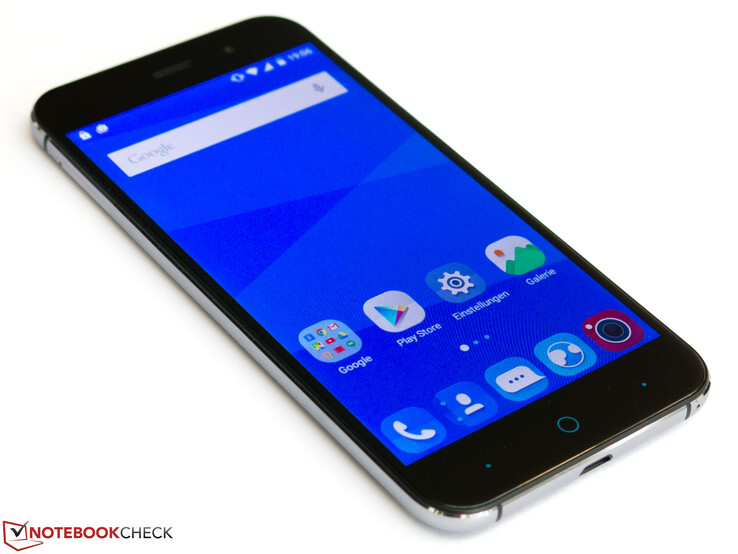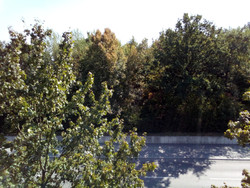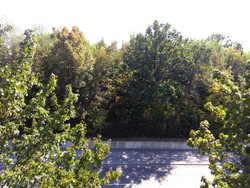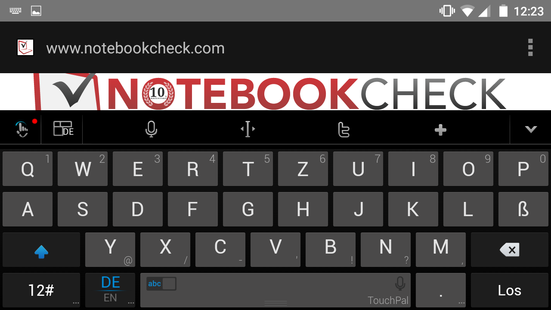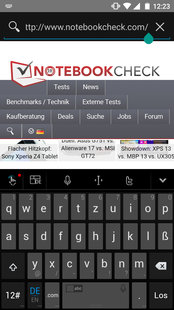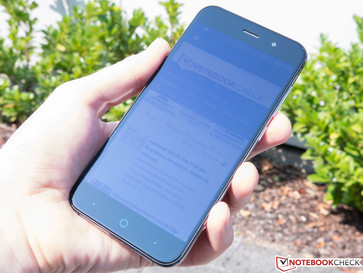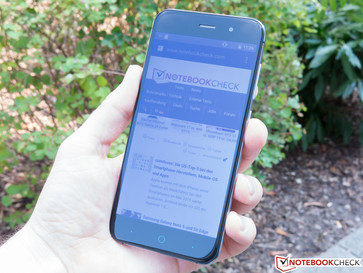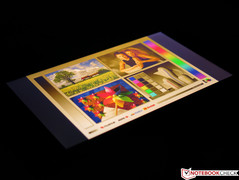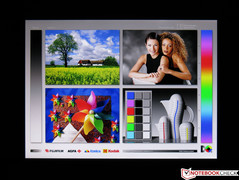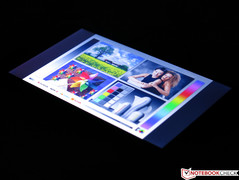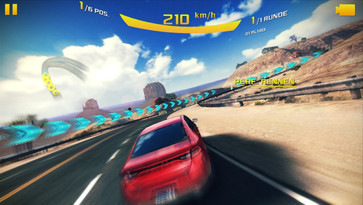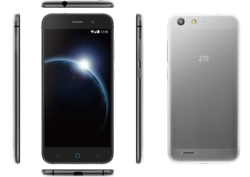ZTE Blade V6 Smartphone Review

For the original German review, see here.
The Blade V6, another mainstream smartphone from the Chinese manufacturer ZTE, is very similar to the Blade S6 that we have already reviewed: Both dual-SIM devices have a 5-inch display with 720p resolution, 16 GB of storage and 2 GB of RAM and are based on Android Lollipop with the additional MiFavor UI 3.0. The recommended retail prices of 249 Euros (~$286) for the Blade V6 and 259 Euros (~$297) for the Blade S6 are very similar.
Some other manufacturers also offer similarly equipped models in the price range of the two ZTE devices. Examples are the Huawei P8 lite, HTC's Desire 626G dual sim as well as LG's G4c. The following review will show how the two ZTE smartphones differ from one another and how the new Blade V6 can keep up with the competition.
Case
Unlike the Blade S6, which has a case made entirely of plastic, ZTE mainly uses aluminum for the Blade V6. The two sides and most of the back are made of metal. Plastic is used only in some areas around the camera module and the speakers. The front on the other hand, is completely covered by glass, which is conveniently rounded in the peripheral areas. This means that the device feels pretty sophisticated and good in the hands, despite the low weight of just 120 grams (122 g/~4.3 oz according to the manufacturer).
The very good torsion resistance of the ZTE Blade V6 supports this impression, so we cannot provoke any creaking even with a lot of force. Ripples on the display are only visible with a lot pf pressure on the cover glass and should therefore not be a problem in practice. There is no criticism for the build quality either and all parts are well integrated.
Connectivity
Even though the Blade V6 is a mainstream model, the connectivity is actually pretty good. LTE support, 16 GB of storage and 2 GB of RAM are decent compared to the rivals – only the sibling Blade S6 and the brand-new Huawei P8 lite can keep up. However, NFC and USB-OTG are not available.
The card tray has obviously been designed with very compact dimensions in mind. It can accommodate a Micro-SIM card at the bottom (slot at the side), while the top can be equipped with either a Nano-SIM card or a microSD card. Unfortunately, the manual with its tiny pictures is not a big help with the correct orientation of the cards. Due to its design, you have to choose between a dual-SIM operation and a storage extension via microSD card. The Blade V6 also supports the transfer of apps to SD cards.
Software
The operating system is Android 5.0.2 with ZTE’s slightly adjusted user interface MiFavor 3.0. The main difference compared with Google’s Android version is the implementation of another launcher that does not use an app drawer. New apps are – similar to Huawei’s solution EMUI 3.1 – shown directly to the left of the home screen. However, it is possible to switch to a second preloaded launcher (Launcher 3) with an app drawer.
It is handy that ZTE has included a rights management for apps ex-works. It can be activated in the "App Rights" in the security settings and is indicated by a permanent symbol in the notification area.
Communication & GPS
The wireless module of the ZTE Blade V6 supports all common GSM, 3G and LTE bands. There were no signal issues during the review period in the Vodafone network, so there is no criticism for the Blade V6 in this respect. Unfortunately, we could not use the dual-SIM function of the review unit, because the OS did not recognize the IMEI of the Nano-SIM slot correctly. These problems will probably be solved by the time the smartphone is available at the start of September.
The Wi-Fi module of the Blade V6 supports only the 802.11 standards b/g/n, while the sibling Blade S6 also works with 5 GHz networks as well as the modern ac standard. However, we managed decent transfer rates of up to 150 Mbps in combination with an Asus RT-AC56U router and the signal quality was convincing. Bluetooth 4.0 is also integrated.
The GPS module can quickly establish a satellite connection outdoors and the location is accurate down to 2 meters (~6.5 ft). It is also possible to locate the position indoors when conditions are favorable, in a single-story supermarket, for instance, but we did not find any satellites on the third floor of a four-story apartment building.
Telephone & Voice Quality
The phone app is the standard Android Lollipop app, but this is not a disadvantage. Besides a speed dial function for favorites, there is a caller list and you have direct access to your contacts. It is also possible to access the numeric keypad for the manual entry of phone numbers via the button at the lower part of the display frame, and there is a search bar for quick selection of contacts.
We can confirm that both sides were easy to understand during a call: The sound was quite natural and free of background noises. The smartphone user is still easy to understand with the hands-free function, so the microphone works pretty well. Unfortunately, the integrated speaker of the Blade V6 is not as convincing: It has a low maximum volume in general, tends to distort, and produces a very tinny sound.
Cameras & Multimedia
The ZTE Blade V6 uses a 13 MP main camera with a dual-LED flash and an additional 5 MP camera at the front. This means that the specs are similar to the comparison devices, only the LG G4c falls slightly behind.
The main camera takes decent pictures under good lighting conditions and you can see many details when you enlarge the picture. Colors are always slightly too saturated, but it does create a vivid picture impression. The situation is not that good when the lighting is poor. While the flash can effectively increase the picture quality when you take close-ups, this is hardly possible at longer distances. The Blade V6 uses very high ISO values (more than ISO 1000) in such situations, when you take a picture of a medium-sized room, for example. The resulting picture noise is completely suppressed by a strong soft focus, but it results in blurry pictures without any details.
As expected, the pictures of the front camera cannot keep up with the main camera in terms of the resolution, but they are still decent. We like the natural color presentation in particular. Because of the lower noise reduction, a picture of the front camera can even show a bit more details under bad lighting conditions compared to a picture that was taken with the rear 13 MP camera (without flash).
The main camera can record Full-HD videos that can convince with a good sharpness and smooth presentation, while the front camera only uses a maximum resolution of 640x480 pixels. The results are stored in a 3GP container file.
Accessories
In addition to the standard accessories like a power adaptor, USB cable and a headset, our review unit comes with a transparent plastic back cover. It does not really increase the thickness and suits the design of the case well.
Warranty
There is no warranty information in the box, but according to the ZTE website, the standard warranty period is two years in Germany.
Input Devices & Handling
ZTE has preloaded the keyboard app "Touch Pal X", which is also active by default. It supports certain customization features including the size of the keyboard, the tactile feedback during typing or automatic word predictions. It is also possible to use the standard Google input. The touchscreen is very accurate and ensures reliable inputs.
The three sensor buttons underneath the display are responsive and execute inputs reliably. They are marked by light-blue symbols and are illuminated in dark-blue for a few seconds when you touch a button. By default, the right button opens an overview about the recently launched apps, while the left one acts as a "Back" button. This allocation can also be reversed in the settings.
Both the volume rocker and the power button leave a good impression thanks to the well-defined pressure points and sufficiently sturdy buttons.
Display
ZTE has equipped the Blade V6 with a 5-inch IPS display and a resolution of 1280x720 pixels. This is the standard for this device category and all our comparison devices use panels with the same technical specifications.
Despite these similarities, we can see rather significant differences in the measurement results such as the maximum brightness, for instance. While the review unit manages just 336 cd/m² in the center, the HTC Desire 626 dual sim is almost 50% brighter at 497 cd/m². The rather mediocre brightness distribution of just 81% is also beaten by all the rivals, and we noticed some screen bleeding in the corners. This means that the Blade V6 is in the last place within our comparison.
The automatic brightness regulation still needs some improvements, because it changed the brightness noticeably under changing lighting conditions. Other devices manage an almost seamless transition that is much less noticeable.
| |||||||||||||||||||||||||
Brightness Distribution: 81 %
Center on Battery: 336 cd/m²
Contrast: 862:1 (Black: 0.39 cd/m²)
ΔE Color 8.29 | 0.5-29.43 Ø5
ΔE Greyscale 8.57 | 0.57-98 Ø5.3
89.7% sRGB (Argyll 1.6.3 3D)
Gamma: 1.96
| ZTE Blade V6 1280 x 720 px 5.0'' (IPS) | ZTE Blade S6 1280 x 720 px 5.0'' (IPS) | Huawei P8 lite 1280 x 720 px 5.0'' (IPS) | HTC Desire 626G dual sim 1280 x 720 px 5.0'' (IPS) | LG G4c 1280 x 720 px 5.0'' (IPS) | |
|---|---|---|---|---|---|
| Screen | |||||
| Brightness middle | 336 | 386 15% | 365 9% | 497 48% | 480 43% |
| Brightness | 315 | 377 20% | 353 12% | 483 53% | 464 47% |
| Brightness Distribution | 81 | 90 11% | 93 15% | 90 11% | 92 14% |
| Black Level * | 0.39 | 0.44 -13% | 0.42 -8% | 0.67 -72% | 0.49 -26% |
| Contrast | 862 | 877 2% | 869 1% | 742 -14% | 980 14% |
| Colorchecker dE 2000 * | 8.29 | 7.12 14% | 5.2 37% | 6.88 17% | 8.13 2% |
| Greyscale dE 2000 * | 8.57 | 6.7 22% | 5.85 32% | 6.11 29% | 6.73 21% |
| Gamma | 1.96 112% | 1.98 111% | 2.17 101% | 1.78 124% | 2.69 82% |
| CCT | 8172 80% | 7784 84% | 7252 90% | 6820 95% | 7727 84% |
| Color Space (Percent of sRGB) | 89.7 | 91.25 2% | 86.5458 -4% | 70.038 -22% | |
| Color Space (Percent of AdobeRGB 1998) | 70.86 |
* ... smaller is better
While the luminance of the Blade V6 is not very high, it manages a very good black value of just 0.39 cd/m². The resulting contrast of 862:1 is roughly on par with the majority of comparison devices and ensures a vivid picture impression.
We used the software CalMAN and a spectrophotometer for more measurements and can determine DeltaE deviations of 8.29 (ColorChecker) and 8.57 (Grayscale), which are not great results (target value smaller 3). White in particular shows a significant deviation compared to the sRGB color space, which is at least covered by 89.7%. The color temperature of 8127 K is also much higher than the ideal value of 6500 K.
The comparatively low display luminance affects the usability outdoors, because the device cannot compensate for the reflections of the touchscreen. Nevertheless, you can see the display content under direct sunlight when you choose a good position, even though the image then appears to have a low-contrast. The situation is obviously better in the shade.
The Blade V6 uses an IPS panel, so there are no inversions when you look at the display from the side. However, you will notice that the color temperature changes when you look at the display from an angle above, but the picture is quite stable when you change the viewing angle horizontally or vertically.
Performance
The ZTE Blade V6 uses a MediaTek MT6735 quad-core SoC, which runs at 1.3 GHz and is based on a 64-bit architecture. According to Geekbench 3, the single-core performance of the processor is between the slightly faster sibling Blade S6 and the slightly slower Huawei P8 lite. However, the latter is equipped with an octa-core SoC and surpasses our review unit in the multi-core benchmark. The situation is similar in the browser tests: While the Blade V6 is average in Google Octane v2 as well as SunSpider, it is in the last place in the Mozilla Kraken benchmark.
The integrated graphics unit Mali-T720 of the MediaTek MT6735 provides average results compared to the rivals, the sibling Blade S6 in particular has a clear advantage in the benchmarks. A positive aspect on the other hand, is the support of the OpenGL ES 3.1 standard.
The situation changes when we look at the performance of the integrated flash storage. A sequential transfer rate (read) of almost 270 MB/s for the Blade V6 is almost twice as fast as all comparison devices. It is also at the top when it reads smaller files. The writing performance cannot quite keep up with this, but the values are still above average.
The system is always responsive and convinces with a smooth representation of animations.
| Geekbench 3 | |
| 64 Bit Single-Core Score (sort by value) | |
| ZTE Blade V6 | |
| ZTE Blade S6 | |
| Huawei P8 lite | |
| 64 Bit Multi-Core Score (sort by value) | |
| ZTE Blade V6 | |
| ZTE Blade S6 | |
| Huawei P8 lite | |
| 3DMark | |
| 1280x720 Ice Storm Standard Score (sort by value) | |
| ZTE Blade V6 | |
| ZTE Blade S6 | |
| Huawei P8 lite | |
| HTC Desire 626G dual sim | |
| LG G4c | |
| 1280x720 Ice Storm Standard Graphics (sort by value) | |
| ZTE Blade V6 | |
| ZTE Blade S6 | |
| Huawei P8 lite | |
| HTC Desire 626G dual sim | |
| LG G4c | |
| 1280x720 Ice Storm Standard Physics (sort by value) | |
| ZTE Blade V6 | |
| ZTE Blade S6 | |
| Huawei P8 lite | |
| HTC Desire 626G dual sim | |
| LG G4c | |
| 1920x1080 Ice Storm Extreme Score (sort by value) | |
| ZTE Blade V6 | |
| ZTE Blade S6 | |
| Huawei P8 lite | |
| HTC Desire 626G dual sim | |
| LG G4c | |
| 1920x1080 Ice Storm Extreme Graphics (sort by value) | |
| ZTE Blade V6 | |
| ZTE Blade S6 | |
| Huawei P8 lite | |
| HTC Desire 626G dual sim | |
| LG G4c | |
| 1280x720 offscreen Ice Storm Unlimited Score (sort by value) | |
| ZTE Blade V6 | |
| ZTE Blade S6 | |
| Huawei P8 lite | |
| HTC Desire 626G dual sim | |
| LG G4c | |
| 1280x720 offscreen Ice Storm Unlimited Graphics Score (sort by value) | |
| ZTE Blade V6 | |
| ZTE Blade S6 | |
| Huawei P8 lite | |
| HTC Desire 626G dual sim | |
| LG G4c | |
| 1280x720 offscreen Ice Storm Unlimited Physics (sort by value) | |
| ZTE Blade V6 | |
| ZTE Blade S6 | |
| Huawei P8 lite | |
| HTC Desire 626G dual sim | |
| LG G4c | |
| GFXBench (DX / GLBenchmark) 2.7 | |
| T-Rex Onscreen (sort by value) | |
| ZTE Blade V6 | |
| ZTE Blade S6 | |
| Huawei P8 lite | |
| HTC Desire 626G dual sim | |
| LG G4c | |
| 1920x1080 T-Rex Offscreen (sort by value) | |
| ZTE Blade V6 | |
| ZTE Blade S6 | |
| Huawei P8 lite | |
| HTC Desire 626G dual sim | |
| LG G4c | |
| GFXBench 3.0 | |
| 1920x1080 1080p Manhattan Offscreen (sort by value) | |
| ZTE Blade V6 | |
| ZTE Blade S6 | |
| LG G4c | |
| on screen Manhattan Onscreen OGL (sort by value) | |
| ZTE Blade V6 | |
| ZTE Blade S6 | |
| LG G4c | |
| Smartbench 2012 | |
| Gaming Index (sort by value) | |
| ZTE Blade V6 | |
| ZTE Blade S6 | |
| Huawei P8 lite | |
| HTC Desire 626G dual sim | |
| LG G4c | |
| Productivity Index (sort by value) | |
| ZTE Blade V6 | |
| ZTE Blade S6 | |
| Huawei P8 lite | |
| HTC Desire 626G dual sim | |
| LG G4c | |
| AnTuTu v5 - Total Score (sort by value) | |
| ZTE Blade V6 | |
| ZTE Blade S6 | |
| Huawei P8 lite | |
| HTC Desire 626G dual sim | |
| LG G4c | |
| AndroBench 3-5 | |
| Random Write 4KB (sort by value) | |
| ZTE Blade V6 | |
| ZTE Blade S6 | |
| Huawei P8 lite | |
| HTC Desire 626G dual sim | |
| LG G4c | |
| Random Read 4KB (sort by value) | |
| ZTE Blade V6 | |
| ZTE Blade S6 | |
| Huawei P8 lite | |
| HTC Desire 626G dual sim | |
| LG G4c | |
| Sequential Write 256KB (sort by value) | |
| ZTE Blade V6 | |
| ZTE Blade S6 | |
| Huawei P8 lite | |
| HTC Desire 626G dual sim | |
| LG G4c | |
| Sequential Read 256KB (sort by value) | |
| ZTE Blade V6 | |
| ZTE Blade S6 | |
| Huawei P8 lite | |
| HTC Desire 626G dual sim | |
| LG G4c | |
| Sunspider - 1.0 Total Score (sort by value) | |
| ZTE Blade V6 | |
| ZTE Blade S6 | |
| Huawei P8 lite | |
| HTC Desire 626G dual sim | |
| LG G4c | |
| Octane V2 - Total Score (sort by value) | |
| ZTE Blade V6 | |
| ZTE Blade S6 | |
| Huawei P8 lite | |
| HTC Desire 626G dual sim | |
| LG G4c | |
| Mozilla Kraken 1.1 - Total (sort by value) | |
| ZTE Blade V6 | |
| ZTE Blade S6 | |
| Huawei P8 lite | |
| HTC Desire 626G dual sim | |
| LG G4c | |
* ... smaller is better
Games
Despite the entry-level GPU, the ZTE Blade V6 can also handle more demanding games like “Modern Combat 5” or “Asphalt 8” without any problems. The latter could even be played with high details, even though the frame rate was noticeably lower compared to the medium settings. Simpler games like “Angry Birds”, for example, are not a challenge for the review unit.
Both the accurate touchscreen as well as the position sensor work very well when you play games.
Emissions
Temperature
The temperatures of the review unit are normal at 31.9 °C (~89 °F) at the front and 30 °C (~86 °F) at the back. The Blade V6 is average under load: While the LG G4c and the HTC Desire 626 dual sim stay slightly cooler, both the Huawei P8 lite and especially the ZTE sibling Blade S6 are rather warmer. Nevertheless, the comparatively moderate warming is clearly perceptible for the user because of the metal surface.
The power adaptor left a negative impression: Temperatures of up to 52.1 °C (~126 °F) are clearly above the results that we determined for the other comparison devices.
(±) The maximum temperature on the upper side is 40.3 °C / 105 F, compared to the average of 35 °C / 95 F, ranging from 21.9 to 56 °C for the class Smartphone.
(+) The bottom heats up to a maximum of 37.6 °C / 100 F, compared to the average of 33.8 °C / 93 F
(+) In idle usage, the average temperature for the upper side is 31.9 °C / 89 F, compared to the device average of 32.7 °C / 91 F.
Speakers
Unfortunately, there is no good news about the speaker at the rear of the Blade V6. The maximum volume is pretty low, which makes it harder to use the smartphone in a large room or the hands-free feature. It also sounds quite tinny in general and there are audible distortions when the volume exceeds 50%. This would be bad enough, but the music playback also creates strong vibrations in the whole rear part of the chassis.
The supplied headset cannot convince us either. The first impression is already pretty bad: It smelled like chemicals when we took the headset out of the box, and there is no marking of the right and left earpiece, either. It is therefore not surprising that the unbalanced sound without bass is disappointing, and it is very shrill at higher volumes.
The sound of the Blade V6 is much better when you use better headphones. It is also possible to activate the software "ARKAMYS OptimSpeaker" in the settings if you prefer more bass.
Energy Management
Power Consumption
The power consumption of the ZTE Blade V6 is usually slightly lower than the rival Huawei P8 lite at 1.2 up to 2.1 watts while idling and 4.1 up to 5.1 watts under load. It is also much more frugal than the sibling Blade S6 that consumes more power in every situation. Another positive aspect is the low standby consumption of just 0.1 watts and that the smartphone does not consume any power when it is turned off.
| Off / Standby | |
| Idle | |
| Load |
|
Battery Runtime
A battery runtime of 6 hours and 40 minutes in our realistic Wi-Fi test is an average result for the Blade V6. Thanks to its larger battery, the LG G4c in particular has an advantage and manages one hour more. However, the competitor from the same company, the Blade S6, also manages 30 minutes more because of the slightly higher battery capacity.
Our review unit is only beaten by the LG G4c under load, all the other rivals have to be recharged sooner. The maximum runtime of 7 hours and 4 minutes in our video test is unfortunately surpassed by many comparison devices.
| ZTE Blade V6 Mali-T720 MP2, MT6735, 16 GB eMMC Flash | ZTE Blade S6 Adreno 405, 615 MSM8939, 16 GB eMMC Flash | Huawei P8 lite Mali-450 MP4, Kirin 620, 16 GB eMMC Flash | HTC Desire 626G dual sim Mali-450 MP4, MT6592, 8 GB eMMC Flash | LG G4c Adreno 306, 410 MSM8916, 8 GB eMMC Flash | |
|---|---|---|---|---|---|
| Battery Runtime | |||||
| H.264 | 424 | 497 17% | 369 -13% | 495 17% | 709 67% |
| WiFi v1.3 | 400 | 432 8% | 351 -12% | 398 0% | 457 14% |
| Load | 230 | 149 -35% | 194 -16% | 220 -4% | 252 10% |
Pros
Cons
Verdict
One highlight of the ZTE Blade V6 is certainly the very sophisticated aluminum chassis for a mainstream smartphone, which can also convince in terms of ergonomics: It feels good in the hand and leaves a sturdy impression despite its lightweight.
The SoC manages average performance results, but is still fast enough to ensure a responsive user experience without delays. Even more demanding games are not a problem. Other advantages are the LTE support as well as the possible dual-SIM operation, which can also be waived in favor of a storage expansion via microSD card. The two integrated cameras take decent pictures in bright environments, but the quality quickly suffers when it gets darker. A nice addition to the usual scope of delivery was the provided back cover.
The biggest issues were the headset that is hardly suitable for music playback, the rear speaker as well as the mediocre luminance of the display. The battery runtimes of our review unit were only average.
The ZTE Blade V6 is a smartphone that can particularly convince us with sufficient performance and a good build quality for a reasonable price of around 250 Euros (~$291). If you need more performance and can live without the nice aluminum chassis, you should have a closer look at the similarly priced sibling Blade S6.
ZTE Blade V6
-
08/19/2015 v4(old)
Andreas Kilian


 Deutsch
Deutsch English
English Español
Español Français
Français Italiano
Italiano Nederlands
Nederlands Polski
Polski Português
Português Русский
Русский Türkçe
Türkçe Svenska
Svenska Chinese
Chinese Magyar
Magyar